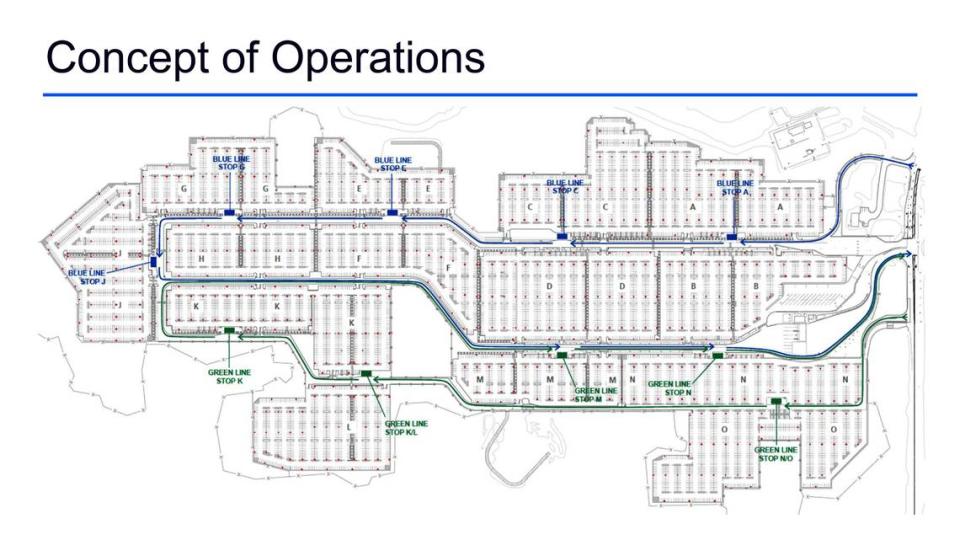For the first time, RDU airport will begin producing some of its own electricity
Most of the electricity needed to power the lights, message boards, ticket machines and bathrooms at Raleigh-Durham International Airport’s largest remote parking lot will be generated on site.
That’s because the roofs of many of the covered walkways being installed in the expanded Park Economy 3 lot near Interstate 40 will be made of solar panels.
The Airport Authority board recently decided to spend an extra $1 million on walkway roofs that can generate power from the sun. RDU expects a federal tax credit will make up about $462,000 of the extra cost.
The airport will make up the remaining $553,000 in savings on its power bills over about 11 years, after which it will come out ahead financially, according to Cole Edmonson, an engineer with Kimley-Horn who evaluated the project for the airport. The solar panels will have a lifespan of about 25 years, Edmonson said.
The solar panels will be the first at RDU. They weren’t part of the plan when the board voted last August to move ahead with nearly tripling the size of Park Economy 3 to about 10,820 spaces.
But board members, echoing what they’d heard from the public and local politicians, pressed the airport staff to consider incorporating solar. They worried about the effects of paving over a mature forest and cited the opportunity provided by the parking lot project.
As the Airport Authority board prepared to vote on the panels earlier this month, Nina Szlosberg-Landis told fellow members that their job goes beyond simply looking after the airport’s finances.
“It is also the trust and taking good care of the airport as it relates to our community that we serve, and that includes reducing our carbon emissions,” Szlosberg-Landis said. “So while this isn’t a huge amount, it’s something. And so we are beginning to do our part.”
The vote in favor of the panels was unanimous.
Contract with Duke Energy limits use of solar
Solar panels will cover only 40% of the walkway canopy roof planned for the parking lot. That’s because under its contract with Duke Energy, the airport cannot produce more power than it can use on site.
The airport still needs to work out the details with Duke, Edmonson said. But by installing enough panels to produce 560 kilowatt hours of electricity, RDU will be able to offset roughly 84% of the energy used at the parking lot each year, he said.
The canopies with solar panels will look and work very much like those without panels, he said.
“Similar footprint in terms of coverage of the sidewalk, similar height, similar aesthetics,” he told the board. “It will also have the ability to manage rain water and storm water just like a regular canopy would.”

RDU is far from the cutting edge when it comes to producing renewable energy. The airport adopted a sustainability management plan last year that includes renewables as a goal, but so far the airport’s energy efforts have been focused on conservation and efficiency.
Meanwhile, in 2010, the Federal Aviation Administration noted the growing interest in airports in producing solar power and published guidelines for installing it. Two years earlier, Denver International Airport began building a solar farm that now covers 56 acres and can generate more than 16,000 megawatt hours of electricity a year, enough to power 2,500 homes.
Among the other airports that generate power from solar panels are Indianapolis International, Los Angeles International and Sacramento International. Chattanooga Airport, where RDU’s president and CEO, Michael Landguth, worked before coming to the Triangle in 2011, has a solar farm capable of producing more than 2.7 megawatts of power, meeting all of the airport’s electricity needs.
RDU is expanding Park Economy 3 to meet growing demand and to help make up for the planned loss of parking spaces elsewhere at the airport. Next year, RDU expects to demolish two small parking decks near Terminal 2 to begin expansion of the terminal building and realignment of John Brantley Boulevard.
RDU expects to spend about $140 million expanding Park Economy 3. The lot, on National Park Drive just off Aviation Parkway, now covers about 36 acres and was surrounded by forest until clearing work began last fall. RDU plans to expand in three directions, adding about 65 acres of pavement and clearing a total of 120 acres.



